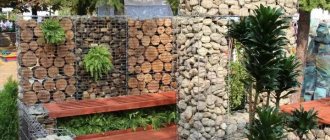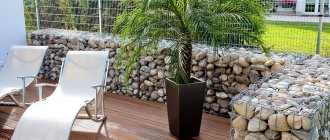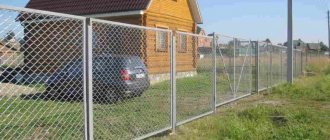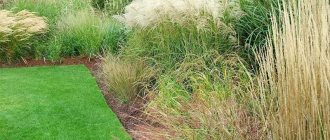Gabions are structures made of a metal mesh frame filled with various materials. If in former times they were widely used by military people for protection from enemies, now the structures have a different purpose. With the help of gabions, they strengthen the banks of reservoirs, the slopes of embankments and hills. Their aesthetic appeal is of no small importance.
From the battlefield to the estates. History of gabions
As you know, many things appeared thanks to, if it is appropriate to say so, wars. Canisters, for example, microwave ovens, adhesive tape or canned food, which Napoleon ordered technologists to invent. The history of gabions is also connected with the French emperor. He widely used tall, bottomless baskets to protect trenches and guns. In Rus', such mobile structures were called tours, and in Europe, gabions, from the Italian word meaning “large cage.”
Gabions are still used in military affairs. But, starting from the end of the century before last, more and more in engineering. Lightweight, mobile, but durable, gabions, as practice has shown, perfectly strengthen slopes, banks, and areas at risk from the point of view of possible landslides.
In recent years, gabion structures have become very popular among “green” architects and landscape designers.
Mattresses or mattresses
This is the name given to flat frames whose height is no more than 30 cm. They are shaped like spring mattresses for beds, which is why they got this name. They are used to strengthen the soil on gentle slopes, as well as for laying the beds of canals and rivers.
The mattresses are laid closely on the slope, connected to each other and secured to the ground with long anchors. A thin layer of fertile soil is poured on top and grass is sown. After some time, the roots of the grass cover penetrate between the stones, serving as additional fastening material. Such a slope will not crumble and will not require repairs or renovations for many decades.
Basic types of gabion products
There are, in fact, three main varieties: gabions are box-shaped, cylindrical and mattress-mattress (in other words, Reno mattresses).
The first, in the form of parallelepipeds, are to strengthen steep banks, slopes, walls, and make high fences from them.
The latter are presented in the form of cylindrical baskets, more suitable for creating decorative accessories - columns, columns and the like.
Third, they line flat areas and fix the bottoms of reservoirs.
These are the basic types of gabions, but of course there are more variations: cubic, spherical, conical...
Gabions can be of almost any shape, with any filling, which makes these structures especially attractive in the eyes of landscape design specialists.
Recommendations for choosing stones for filling
Cobblestones can be shaped with sharp corners or polished. It is allowed to combine stones by color and shape.
Important: The dimensions of each stone must be 1.2-1.5 times larger than the mesh size.
Well, they shouldn’t exceed the specified size by much. The filling must have the following characteristics:
- For structures located on a dry site, the specific gravity of the filling should not exceed 17.5 kilonewtons per cubic meter. For structures in contact with water, this figure is increased to 23;
- It must be frost-resistant up to 350 cycles;
- Strength 400 units;
- Low water absorption coefficient;
- Relative hardness.
The priority is rubble stone for gabions and crushed stone. The decorative properties of the configurations depend on the choice of material.
Natural stone is not cheap, so to reduce the cost it is used only in visible areas of the structure. Construction waste and soil in geotextile for gabions can be placed inside.
Among gardeners, non-standard fillers are especially popular. For example, wooden chocks. However, here you need to remember that wood is susceptible to moisture, so the structure should be protected from precipitation. When choosing a filler, it is important to remember that it must correspond to a single style.
Advantages and disadvantages of gabions
Mesh cells have quite a lot of advantages, among them:
- Durability . Typically, the gabion frame consists of very strong, double-twisted wire and reinforcement.
- Durability . Gabion products do not crack, tear, break under loads, or deform when the soil settles.
- Flexibility . Thanks to the wire structure, the “big cages” tolerate soil erosion without problems, even if it occurs at the base of the structure.
- Moisture resistance . Gabions absorb water without being destroyed. This quality is especially valuable if the site is located in the so-called erosion zone. Gabions are also irreplaceable when additional drainage is required.
- Air permeability . Giving the impression of a blank, monolithic fence, gabions nevertheless allow air to pass through well.
- Environmental friendliness . Everything that has the prefix “eco” is in fashion, and gabions are an example of naturalness.
- Aesthetics . Gabions have a bold, textured, always neat appearance.
- Affordability . Gabions are significantly cheaper than their concrete counterparts and are easy to use.
Do they have any disadvantages? Many consider the disadvantage to be the difficulty of installing large and tall gabion sections. In this case, specialists are hired for installation.
Characteristics
The service life is determined by the use of elements of different textures. For the frame, strong, twisted metal wire is used. It is made of steel and coated with zinc. You can also find products covered with anti-corrosion PVC film, the thickness of which varies from two to six millimeters.
Reference: This type of wire is 5 times stronger than the material for chain-link mesh.
The metal frame has sufficient strength, since double twisted wire is used in its manufacture. If the structure is large, then the frame is pre-divided into compartments. The peculiarity of the metal base is its flexibility and adoption of original shapes even under the influence of weather conditions.
Where are gabions used?
The scope of application of mesh containers is quite extensive. We list the most popular options for using gabions in landscape design:
— Terracing . Gabions will save the unfavorable terrain. With their help, you can straighten and level a platform located at an angle, creating a multi-stage terrace.
— Retaining walls . Boxes filled with stones, wooden blocks or saw cuts are in amazing harmony with lush greenery and flowers. And if you add a canopy or arch to this symbiosis, you will get a secluded, shady gazebo.
— Fences and enclosures . Gabions, combining various fillers, can surround the entire estate. Or cover outbuildings or cover the compost pit. Both the entire fence and, for example, its basement part are built from gabions. Then wooden panels or boxes with vegetation are attached to this base.
You can alternate hedges and gabions: a beautiful bush, next to a mesh section and again a bush. Where large fences are undesirable, low barriers and even borders are made from gabions.
The field for creativity, “game”, and configurations is so wide that a separate term has appeared - pergons. So, they call the same bulk walls and partitions, the function of which is to zone and decorate the site. The pergons make it both colorful and neat at the same time.
Fences made of gabions and pergons - photos
— Reservoirs . The bottom is strengthened with mattress gabions, and the banks with box-shaped gabions. Experts especially recommend finishing the reservoir with gabions if the soil on the site is too wet and requires improvement of the drainage system.
At the same time, please note that the shape of the reservoir can be any, and gabions can become not only a successful engineering solution, but also a beautiful finish for the reservoir. Form them into sides, and an ordinary pond will be transformed into a noble pool.
— Outdoor fireplaces , hearths, barbecues can also be made of durable boxes filled with fire-resistant stones.
— It’s quite possible to make garden furniture, benches and tables from small gabions.
Such items are made by combining various fillers or the gabions themselves with other materials - ceramic tiles, tempered glass, wood. For example, a compact pile of light stones, fastened with a mesh and covered with glass, easily turns into a tea table. A larger wooden tabletop on a gabion becomes a dining table. You can even make a garden version of a bar counter from gabions.
- Rock garden - and it can be made by resorting to a mesh structure. Such an alpine slide will not “creep”, maintaining a somewhat strict but effective appearance.
Gabions, in addition, accent flower beds, frame stairs and paths, individual trees, and form them into columns, arches, stands for garden lanterns, urns and flower vases, abstract figures and even sculptures...
Gabions are an unusually versatile and flexible building and design material. This property is imparted to them not only by their flexible design, but also by their filling. After all, the “filling” of cellular boxes can be very different!
Step-by-step installation of a fence made of mesh and stones
Having decided on the choice of material and location, you need to take care of the equipment:
- Oilcloth;
- Filler;
- Ready mesh;
- Fittings;
- Spirals;
- Staples;
- Boards for formwork;
- Cement-sand mixture;
- Shovel;
- Building level;
- Roulette.
If you plan to make a frame from rods with your own hands, then you will need a welding unit.
Marking
First, the area is cleared. Then the top layer of soil is removed by 15-20 centimeters. Every 2 meters, pegs are driven into the ground and a rope is pulled between them, defining the perimeter of the building.
Foundation
For long-term use, it is recommended to pour the foundation. However, this step can be skipped.
It is necessary to dig a trench, the width is determined by the size of the fence, and the depth by the type of soil. Then the bottom and sides are covered with shingles (oilcloth). It will not allow weeds to grow and prevent the destruction of the structure. Next, add a small layer of sand. Prepare reinforced rods, drive them in, install formwork from boards. Fill with cement. Drying time depends on the brand of cement, but on average it takes 14 days.
Frame installation
The structure consists of a base (bottom), side walls, cover, ends and lintels. The fence should be assembled starting from the posts. First the corners are joined. The base is attached to the posts using welding or bolting. Connect the compartments. The lid is installed on the boxes in a spiral only after the stones have shrinked.
Grid Filling
This stage cannot be rushed, since the stones must lie closely. It is advisable to lay them like brickwork. After filling four rows, the walls of the structure are tightened with steel cables or jumpers. Small stones should be placed on them and only then larger ones.
To ensure uniform upward shrinkage, the structures are filled with medium-fraction stones. After completing the work, the fence should be washed with water. To save money, you can lay fabric filled with construction waste and broken bricks in the invisible part.
What is gabion mesh filled with?
The first, “soldier’s” containers were filled with earth, grass and driftwood, with everything that came to hand.
The most popular, however, are gabions with stone “insides”. By the way, these have been made since ancient times not only in Europe, but also in Japan. Suitable fragments of granite, sandstone, dolomite, marble, gypsum spar, quartzite, limestone, gneiss, basalt, crushed stone, river pebbles... An ordinary cage filled with stones will suit any architecture, any style of landscape art.
But it’s not a sin to deviate from the classics. Let's say, add artificial ones that glow in the dark to natural minerals - can you imagine how enchanting this structure looks with luminescence?
Quite often, different types of stone are also combined to create, for example, a color gradation: a dark base and a light, “airy” top. Or lay out a pattern - with stones of one shade against the background of stones of another, contrasting one.
It turns out beautifully when, for example, black labradorite is alternated with light, silvery quartzite, rich red or green granite, forming stripes or waves.
It also happens that pieces of glass are interspersed into gabions and LED lighting is attached inside. These luminous boxes look like frozen, petrified flames.
Do you like naturalness and ease? “Then we recommend not filling the containers to the very top, but leaving them half empty: over time, grass will grow in the gaps between the stones, and you will get semi-grass gabions.
In addition to stones, mesh containers are filled with saw cuts, logs, fragments of brick or tiles, bark or glass bottles... Anything that fits into the style and design.
Materials for making boxes
Today it is not difficult to purchase ready-made boxes for gabions made of mesh and steel bars, but in order to save money, as well as to produce structures of unique shapes and sizes, it is worth trying to make them yourself. For this you will need:
- reinforcing rolled or sheet welded mesh;
- reinforcing bars for the manufacture of a rigid frame and anchors securing the structure in the ground;
- steel wire for fastening gabions together;
- paint to protect metal from corrosion.
Streck mesh reinforcement cell 10x10mm, 1x10m roll=10m2
In addition, you will need pliers to bend the wire and wire cutters to cut it, as well as metal cutting scissors to cut the rolled mesh. To create products of complex shapes, you need a welding machine and, of course, at least minimal ability to weld metal. It will be very good if you have a stapler for working with thick staples, which will significantly simplify the process of fastening mesh parts together. If you don’t have this tool, it doesn’t matter: wind the wire around a thin tube to create something like a spring, then use it to twist the parts.
The gabion mesh must be strong to support the weight of the stones. This is especially important if you plan to install large jumbo boxes over a meter high on your site. The mesh thickness and other characteristics are given in a special document - GOST R52132-2003. Please note that the gabion parameters indicated in it are designed for the construction of large-scale hydraulic structures.
When making small structures for a private farmstead, the strength requirements will be much less stringent. The wire diameter can remain within 2.5-3 mm. The wire for twisting individual parts into a single structure must be the same diameter as the wire for the mesh. To ensure that decorative gabions retain their presentable appearance for as long as possible, the frame is made of galvanized wire, or better yet, of polymer-coated wire. If you cannot find a suitable material, after assembling the box, you can paint it yourself in any color of your choice.
Wire 0.8mm 50m copper
What you need to know about installing gabions
Today, containers for gabions, so to speak, “semi-finished products,” are sold in any construction supermarket. The double torsion mesh from which such blanks are made is most often galvanized and coated with an anti-corrosion compound, which makes it resistant to negative natural influences.
The market also offers especially durable containers made from jumpers and rods connected by welding. The greater the load expected, the coarser these rods are, and the more frequent the jumpers.
As for the filler, there is a proven formula: for “land” structures, the size of the stones should be about a third larger than the diameter of the cell. For underwater gabions, only stones larger than the cells by 50% are suitable.
If you are installing gabions to strengthen the soil or support, take into account the properties of the filler stone, its strength, resistance to frost, and moisture resistance. There are, of course, fewer requirements for decorative gabions.
About installing gabions with your own hands
The place where it is planned to strengthen the gabion must be thoroughly cleaned and leveled. Then remove the turf and make a recess along the width of the future box. Straighten it, compact it. It would be a good idea to lay geofabric on the bottom of a gabion that has not yet been installed. Sprinkle gravel on top and compact it.
Next, the walls of the gabion need to be assembled into a box. First, its corners are connected using wire, then the edges are fastened.
If the purchased gabion is not in the form of a finished, welded section, then reinforcement should be driven into the corners of the assembled structure and then dug into the ground.
Now the resulting box must be installed in the prepared trench. The structure will fix itself and get stuck in the ground on its own, under the weight of the stones - this is another advantage of gabions.
It is much more difficult to install large containers - for retaining walls or high fences. In this case, stabilizing columns are first placed and concreted, on which the mesh is then strengthened.
To connect individual gabion blocks into a monolith, use a steel spiral or staples.
Fastening gabions with a spiral
Fastening gabions with staples
You need to slowly fill the boxes with stones. The debris is selected so that the voids between them are barely visible.
Fine-mesh containers can be filled with crushed stone or gravel directly from the bucket.
Gabion filling technology
When the gabion is loaded to a third, its walls should be tightened using special hooks. This prevents the gabions from expanding under the weight of the filler.
The “filling” should overfill the mesh container by a few centimeters, because the stone will subsequently settle a little.
Finally, the finished structure is washed with water from a hose and... They decide what to do next. Leave it “a la naturel” or decorate it, for example, with wooden panels, flower boxes, vines that can be planted directly in the crevices between the stones.
How to make it yourself
You can install the gabion yourself. Taking into account the large weight of the final structure, they should be installed immediately, directly on site, be it a retaining wall or another structure. The installation is carried out taking into account the slope of the terrain; you can call in a specialist, an installer.
You can make it yourself from a masonry mesh or a tightened wire spiral for gabions, which is passed between the cells.
Preparation of materials
The following materials and tools are required for assembly:
- Galvanized mesh;
- Fittings;
- Staples or spirals;
- Crimping tool (can be mechanical or pneumatic);
- Ticks;
- Geotextiles;
- Pillars;
- Stones;
- Shovel.
In some cases, the rods are connected by welding, so it is necessary to provide a welding machine.
Manufacturing stages
The site where the gabion is planned to be erected is selected in advance, as well as markings are applied. All further manipulations can be broken down step by step:
- The area is cleared and weeds are removed. The top layer of soil will need to be removed, since in the future a sand cushion will be installed here, the thickness of which should be at least 20 centimeters.
- Make a small diversion from the accumulation of water. For the same purpose, it is recommended to lay geotextiles.
- The mesh is cut according to size.
- The lower part of the structure is formed and only then the side walls are installed.
Advice: if you plan to build a large gabion, then you need to divide the structure into compartments by installing partitions made of similar material.
In rectangular gabions, the top part is left open for filling.
To strengthen the base, reinforcement with a diameter of at least 10 millimeters is used.
When the mesh is ready, it is filled with stones and gravel to the very top, and then the upper part is closed.
Gabions in landscape design - photo
0 0 votes
Article rating
see also
Wiktionary has an entry for "gabion"
- Landscape design
- Geosynthetics
| : Incorrect or missing image | To improve this article it is desirable:
|
| Middle Ages | Loophole · Parapet · Boulevard · Wagenburg · Gabion · Gersa · City Gate · Gulyai-Gorod · Gurdicia · Dansker (dantzker) · Donjon · Killer Holes · Zaborol · Castle · Zaseka · Zahab · Concentric castle · Kremlin · Fortress fence · Mashikuli · Motte and bailey · Spinning · Drawbridge · Parapet · Forward ditch · Reduit · Slingshot · Sortia · Citadel · Garlic |
| New time | Basteia · Bastion · Bastion system of fortifications · Barricade · Batardo · Battery · Blockhouse · Bolwerk · Parapet · Valgang · Glacis · Gorja · Hornwerk · Casemate · Caponier · Counterguard · Counter-scarp · Kronwerk · Curtain · Coupure · Lunette · Cavaliere · Ravelin · Redan · Redoubt Sandbags Defensive Barracks Tenal Fas Flank Flanking Structure Fascine Flèche Fort Fossebreya Tchanets Escarpment |
| 19th century | Armored carriage · Fahrpanzer · Machine gun nest · Barbed wire · Barbette · Border post · Armored turret battery · Coastal artillery · Gun turret · Coastal fortifications · Gabion · Landmine · Trench · Strong point · Polygonal fort · Draft · Tobruk · Deadlock |
| 20th century and modern times | Automatic turret · Arched shelter · Dugout · Bunker · Bunker · Pillbox · Anti-aircraft towers · Barbed tape · Spotykach · Defensive line · Covered gap · Forefield · Anti-tank hedgehog · Anti-tank bumps · Anti-tank obstacles · Bruno's spiral · Tank in a trench · Electric fence · Fortified area HESCO bastion |











